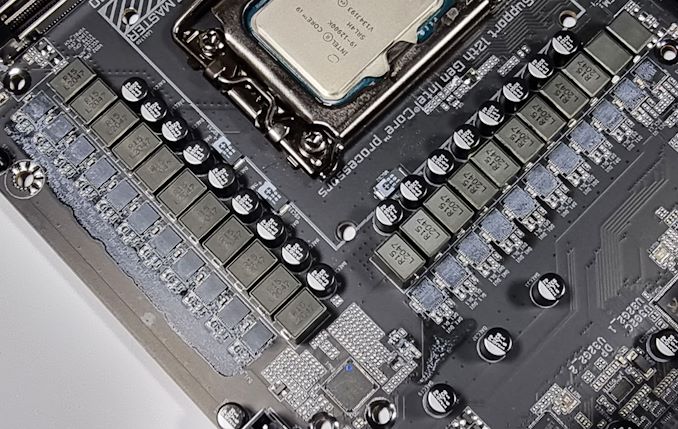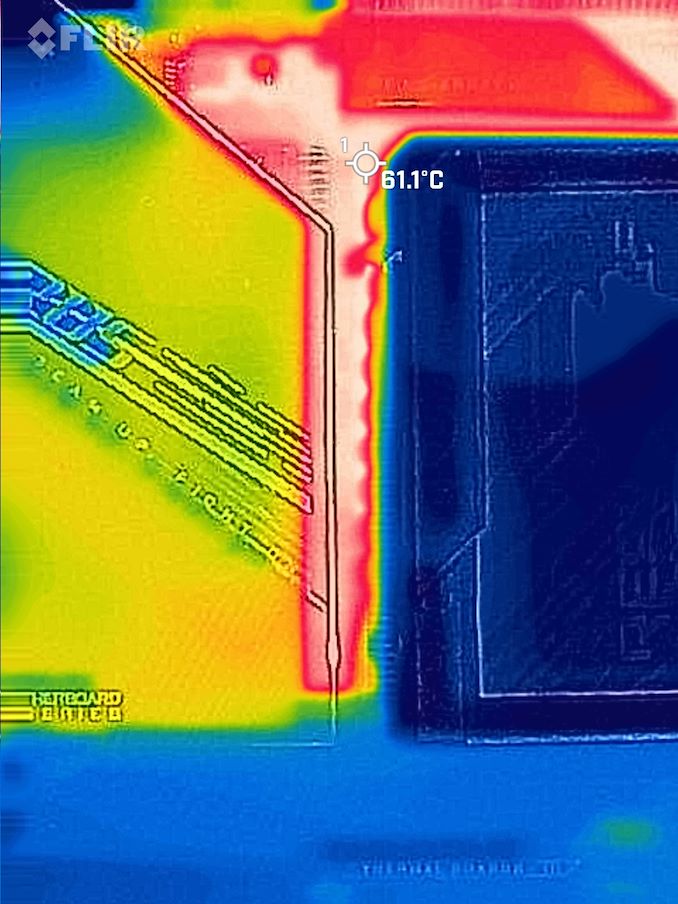The GIGABYTE Z690 Aorus Master Mobo Review: 10GbE Rounds Out A Premium Board
by Gavin Bonshor on February 25, 2022 9:00 AM ESTPower Delivery Thermal Analysis
One of the most requested elements of our motherboard reviews revolves around the power delivery and its componentry. Aside from the quality of the components and its capability for overclocking to push out higher clock speeds which in turn improves performance, is the thermal capability of the cooling solutions implemented by manufacturers. While almost always fine for users running processors at default settings, the cooling capability of the VRMs isn't something that users should worry too much about, but for those looking to squeeze out extra performance from the CPU via overclocking, this puts extra pressure on the power delivery and in turn, generates extra heat. This is why more premium models often include heatsinks on its models with better cooling designs, heftier chunks of metal, and in some cases, even with water blocks.

The 20-phase (19+1) power delivery on the GIGABYTE Z690 Aorus Master
Testing Methodology
Our method of testing is if the power delivery and its heatsink are effective at dissipating heat. We do this by running an intensely heavy CPU workload for a prolonged method of time. We apply an overclock, which is deemed safe and at the maximum that the silicon on our testbed processor allows. We then run the Prime95 with AVX2 enabled under a torture test for an hour at the maximum stable overclock we can, which puts insane pressure on the processor. We collect our data via three different methods which include the following:
- Taking a thermal image from a birds-eye view after an hour with a Flir Pro thermal imaging camera
- Securing two probes on to the rear of the PCB, right underneath CPU VCore section of the power delivery for better parity in case a probe reports a faulty reading
- Taking a reading of the VRM temperature from the sensor reading within the HWInfo monitoring application
The reason for using three different methods is that some sensors can read inaccurate temperatures, which can give very erratic results for users looking to gauge whether an overclock is too much pressure for the power delivery handle. With using a probe on the rear, it can also show the efficiency of the power stages and heatsinks as a wide margin between the probe and sensor temperature can show that the heatsink is dissipating heat and that the design is working, or that the internal sensor is massively wrong. To ensure our probe was accurate before testing, I binned 10 and selected the most accurate (within 1c of the actual temperature) for better parity in our testing.
To recreate a real-world testing scenario, the system is built into a conventional desktop chassis which is widely available. This is to show and alleviate issues when testing on open testbeds, which we have done previously, which allows natural airflow to flow over the power delivery heatsinks. It provides a better comparison for the end-user and allows us to mitigate issues where heatsinks have been designed with airflow in mind and those that have not. The idea of a heatsink is to allow effective dissipation of heat and not act as an insulator, with much more focus from consumers over the last couple of years on power delivery componentry and performance than in previous years.
For thermal imaging, we use a Flir One camera to indicate where the heat is generated around the socket area, as some designs use different configurations, and an evenly spread power delivery with good components will usually generate less heat. Manufacturers who use inefficient heatsinks and cheap out on power delivery components should run hotter than those who have invested. Of course, a $700 flagship motherboard is likely to outperform a cheaper $100 model under the same testing conditions, but it is still worth testing to see which vendors are doing things correctly.
Thermal Analysis Results

We measured 61.1ºC on the hottest part of the CPU socket during our testing
The GIGABYTE Z690 Aorus Master has a large 20-phase power delivery, which is controlled by a Renesas RAA229131 20-channel PWM controller that is operating in a 19+1 configuration. The CPU section includes nineteen Renesas 22010540 105 A power stages, while the SoC is using one Intersil 99390 90 A power stage. Keeping the power delivery cool is a large two-section metal heatsink that is interconnected by a single heat pipe. The heatsinks themselves feature multiple fins designed to direct the passive airflow to aid in heat dissipation.
Comparing the GIGABYTE Z690 Aorus Master against boards at a similar price point, it performs well in regard to power delivery thermals. Currently, the Z690 Aorus Master has the coolest power delivery of any Z690 board we've tested so far, and it is something GIGABYTE has been good at on its premium models over the last couple of years. We noted temperatures of 65°C from the integrated VRM sensor, as well as temperatures of 64°C and 66°C from our pair of K-type thermocouples.











35 Comments
View All Comments
Silver5urfer - Saturday, February 26, 2022 - link
You should have gone with MSI Unify X or ASUS APEX series for DRAM performance. Tachyon was not good for Z590 not sure how it is for Z690.meacupla - Friday, February 25, 2022 - link
Were you able to get memory to overclock beyond its stock 4800?The board's spec does say it supports up to 6400.
Because I have doubts that this board can really do 6400, when it has 4 slots.
Jp7188 - Sunday, February 27, 2022 - link
It would be great if Anandtech would do a piece comparing memory overclocks on the various boards. I was super excited to get my hands on a 6400 CL32 kit only to find it wouldn't work at full speed in the Aorus Master while it apparently does in other boards from ASUS and MSI. Fast mem with tight timings appears to be a significant differentiator for this generation of motherboards.Infy2 - Sunday, February 27, 2022 - link
Testing 2022 hardware with graphics card from 2016, time to upgrade I think? A powerful CPU like Adler Lake with such an obsolete graphics card will hardly show meaningful differences in gaming performance.shabby - Monday, February 28, 2022 - link
Insert AnandTech gpu review joke here...DanNeely - Monday, February 28, 2022 - link
The only way you're going to see any differences from CPU performance is to turn the graphics settings down to the point where the GPU isn't fully loaded and the CPU itself becomes the bottleneck. At that point any vaguely half decent card will work.Tom Sunday - Sunday, February 27, 2022 - link
Yes the GIGABYTE Z690 Aorus Master is pricey to say the least. I like to think being an enthusiast myself, but at the same time not convinced that l will be able to really taking proper advantage of all the Z690 Aorus Master offered premium features. It’s almost March/April now knocking on our door and I wonder with Intel breaking-out in the second half of 2022 their next-gen 13th Gen Core Raptor Lake, is it actually time to hold off building or even thinking now about an all new premium ($$$$) system? Intel proffers in featuring double-digit performance increases and greater core and thread counts. Moreover a more matured Alder Lake tech! Motherboard vendors in turn already doing a similar marketing dance of much improved MB-tech over their fall 2021 or early 2022 premium products. The old story prevails! “When to hold and when to fold with ones dollars?TLindgren - Monday, February 28, 2022 - link
Yeah, it's expensive but the real problem this motherboard have is that Gigabyte has a cheaper motherboard that is arguably better in many ways, the Z690 Aero D! The Master does have better integrated Audio though - the Aero D's ALC4080 is just as good as the Master's ALC1220 but they skimped on audio connectors so the Aero D is only 2.0, not 7.1.Differences:
* Aero D offers both x16/x0 or x8/x8 PCIe 5.0 vs the Masters x16 PCIe 5.0 plus PCIe 4.0 4x!. Both have a third x16 running in x4 PCI 3.0.
* Both have the same 10Gbps network chip, Aero D adds a 2.5Gbps to that.
* Aero D adds dual Thunderbolt (replaces the "plain" USB-C connectors)
* Aero D had DP+HDMI for the iGPU, Master has just DP - these outputs are useful for debugging and adding more screens while still rendering on the dGPU. With TB the Aero D has potentially four extra screens while Master has one!
* Audio is a clear win for the Master - the audio codec on the Aero D should be comparable to the one used on the Master, but it doesn't have ports in the back for more than 2.0 audio!
* Master has 5 M.2 compared to Aero D's 4.
* Master has 9 USB Type-A compared to Aero D's 6.
* Master has... "voltage measurement points". Swoon (not!).
I consider the extras the Aero D has to be far more consequential than the extras the Master has, *except* Audio.
The four PCIe 5.0 switches in the Aero D should cost Gigabyte more than the improved Audio on the Master and that ignores that Aero D also have 2xThunderbolt and a second LAN controller.
So, exactly why does the Master cost $499?
The answer is of course that retail pricing is controlled by what they think they can take for it, not what it costs to make, as long as they're not loosing money of course.
DanNeely - Monday, February 28, 2022 - link
With garbage 2.0 audio out the Areo D belongs in the $20 or less liquidation junkbin if not the dumpster out back.nevcairiel - Monday, February 28, 2022 - link
I haven't used analog audio connectors in years. Headphones run a USB DAC, desktop speakers are just stereo, and actual movie watching uses HDMI to a receiver.Gladly safe a whole bunch of money if audio is the only meaningful difference I don't care about. Not that I'm going to buy anything Gigabyte anyway..